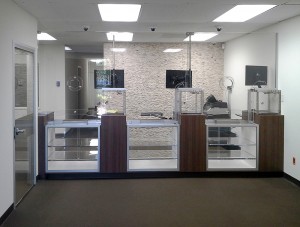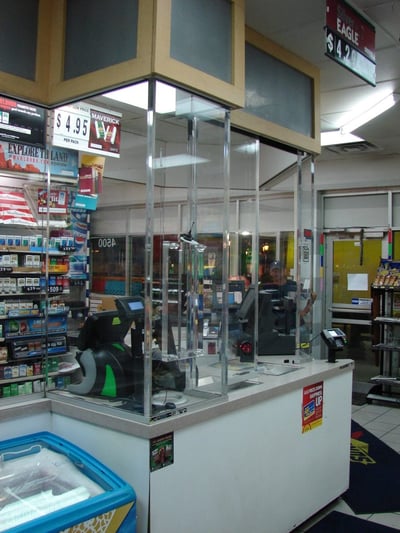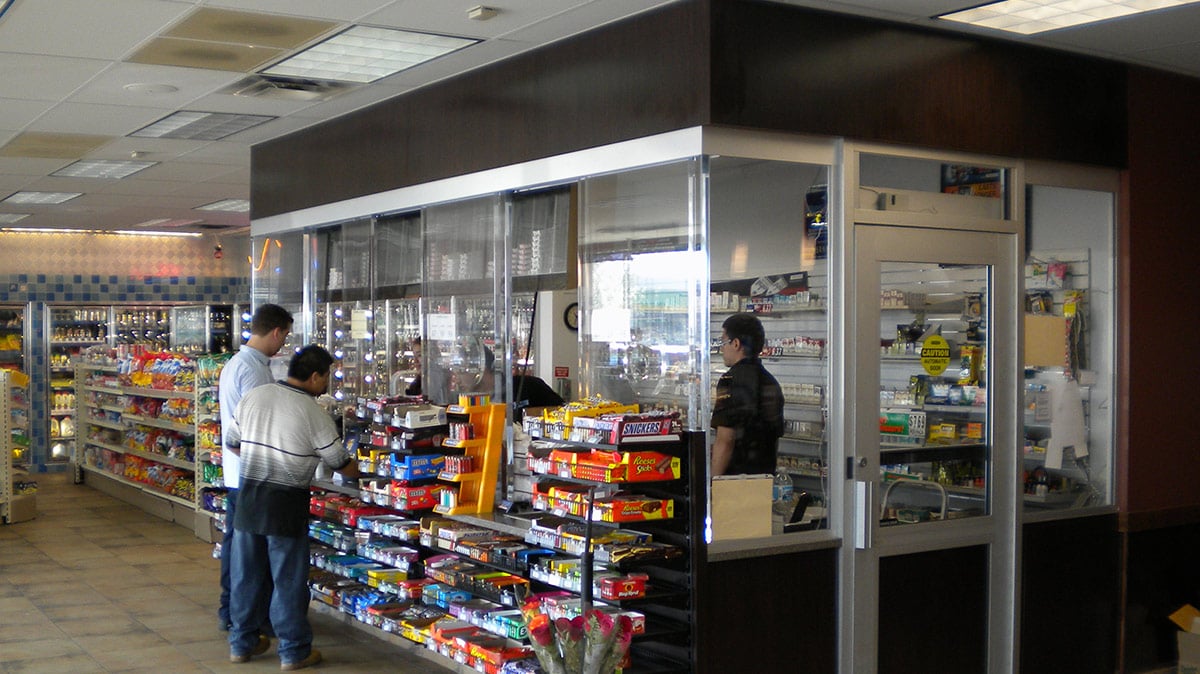In the United States, the vast majority of serious crimes go unpunished. According to a 2020 report from Pew Research, about 60% of all violent and property crimes are never reported to the police. Of those crimes that are reported, most go unsolved.
In summary, property crime is the majority of all crime, and is 55 times more common than violent crime. However, only 5% of all property crimes will be solved. A system where 95% of all robbers go unpunished can’t possibly be doing much to deter crime. As such, it falls on businesses to take protective measures on their own.
In their landmark report on convenience store robberies, the U.S. Department of Justice (DoJ) noted that convicted robbers (by their own admission) specifically select targets based on their belief that “victims [businesses] will not install preventative measures to stop them.”
It’s become increasingly obvious that, for retail, the best safety measures are those that borrow from the CPTED (crime prevention through environmental design) toolkit adopted by schools and municipal offices since the early 2000s. These are simple design decisions any business can implement, which deter crime without increasing risks for their workers.
Preventative Safety Measures that INCREASE Danger
The DoJ report noted that stores were “most vulnerable to revictimization within the first few weeks after the first robbery.”
This tends to argue for a quick response after a robbery. But many of the most common measures retailers quickly put into place have unforeseen consequences.
For example, many stores seek to increase safety by doubling up employees during riskier hours of operation. Some cities even mandate such measures. These laws followed a series of studies in Florida in 1986, which “concluded that the number of clerks on duty was a strong predictor of [reduced] robbery potential.”
But later research cast doubts on those findings. A larger review of convenience store robberies by the National Association of Convenience Stores found no such correlation between increased staffing and decreased robbery.
Another popular “quick fix” security measure is to limit cash on hand or worker access to cash. This usually means frequent cash drops or timed safes. But this measure similarly failed to reliably mitigate risk. According to the Department of Justice:
“Although some researchers believe that limiting cash on hand to less than $100 could reduce robbery risk and injury rates, other research has found that limiting cash … can force a robber to take greater risks, thereby potentially increasing employee injury rates.”
Adding armed security had even worse outcomes in the real world:
“One study found that there was approximately a ‘sevenfold increase in the risk of a worker being killed in workplaces that allowed guns,’ implying that workplaces that respond to a prior experience with crime by allowing firearms may actually be creating a greater risk for workplace homicide.”
Increasing Safety with CPTED
Crime prevention through environmental design (CPTED) is a proven low-cost, high-impact strategy for increasing safety and preventing crime. It’s been applied for decades in some major U.S. cities, where its use correlates to a 30% to 84% decrease in robberies.
The Department of Justice’s report noted two CPTED strategies. These offer the best combination of increased security with minimized risk to workers.
- Increase Natural Surveillance: Make it easy for observers to see what’s happening and note anything suspicious
- Enhance Territoriality: Use design elements to reinforce boundaries and empower workers
A well-designed bullet-resistant security barrier can do both of these, while simultaneously shielding workers if worse comes to worst.
Learn about the 8 Levels of Bullet Resistance and which level will work for you
Natural Surveillance
According to the Department of Justice, “Several characteristics of a store’s interior layout can influence its vulnerability to a robbery. Common among these is visibility.”
There are several elements at play here. First and foremost, employees need a clear view of the entire interior of the store and approaches. This allows them to retain the initiative in a conflict—which often means avoiding a conflict altogether.
As the report puts it: “Employees should have an optimal view of the entrance and interior of the store. This involves having adequate interior and exterior lighting, unobstructed views into the store, and strategic placement of the cash register.”
Secondly, passersby (including law enforcement) should be able to see into the store. The DoJ cited several studies confirming this. “Robbers are deterred by brightly lit stores in which employees and the store’s cash registers are clearly visible from the street. … An unobstructed view of the entrance and interior of the store provides natural surveillance that increases the risk of apprehension for the offender.”
Consider these recent projects. Both are attractive and unobtrusive, allowing for excellent sightlines and visibility.

A bullet-resistant barrier with extremely high visibility
This gas station retrofit is an especially good example. Convenience stores like these often suffer from bad sightlines. The business necessities (i.e, maximizing the revenue per square foot) are naturally in conflict with the need to maximize visibility. Many bulletproofing companies struggle to resolve this conflict.

Custom bullet-resistant barrier that maximizes sight-lines and “natural surveillance” in convenience retail
Here Total Security Solutions was able to craft a complex ballistic barrier system that followed the contours of the counter. This maximized retail space while keeping the clerk center stage, visible to the outside world, and able to see trouble coming.
CPTED and Territoriality
Territoriality is a core aspect of CPTED. When you use design elements to reinforce boundaries and clearly communicate whose “territory” we are in, you automatically disadvantage attackers and empower workers. This doesn’t just increase the likelihood that a worker will survive a robbery; it prevents robberies altogether.
As the DoJ explained: “The store’s location within the community, traffic flow, signs and advertisements, and design elements that empower the employee (such as bulletproof barriers) are components of [establishing territoriality].”
This isn’t just about clearly marking out property lines, boundaries, and public vs. “employee only” areas. Attractive security also subtly (yet persuasively) communicates that the retail space matters. Someone who has the means and willingness to defend that territory cares.
That message isn’t just for possible offenders. A high-quality ballistic barrier—one that looks good and shows care in its design and installation—communicates a powerful message to employees:
You are valued. We want you to be in a position of relative strength while performing your job.
Knowing this empowers those employees to maintain the upper hand at all times, both because of reduced risk to themselves and because they innately feel they have the support of their employer.
According to the DoJ, “By encouraging simple practices in demeanor—greeting customers and establishing eye contact—clerks can learn to ‘put robbers on stage.’ One comprehensive study of convenience store robberies concludes that ‘the behavior of clerks may be the most significant factor in determining the extent of injury that results during these robberies.'”
Reinforcing the worker’s sense of their own value and strength increases safety (while improving business).
Expressing Your Values with CPTED
Over the past five years, Total Security Solutions CEO Jim Richards has seen the impact workplace violence has had on the retail sector. “Security levels are up across the board in retail,” Jim notes. “That includes trending toward higher-level barriers.” The kinds of security measures primarily seen in courthouses and police stations are becoming increasingly common in mobile phone shops and convenience stores.
“We’re also seeing more independent fast-food places,” Jim explains. These are regional chains with eight to ten locations, where a handful are in areas with increased crime. “Those can be tough jobs already. The same things that make a location attractive for running a quick-service restaurant—being near the highway, having easy access from multiple directions, keeping long hours—also makes you an attractive target for armed robbery. The sense I get is that the people who run these businesses want security that empowers their workers and keeps them safe at all costs. It’s the workers [they want to protect] more so than the money. Seven or eight years ago these same sorts of businesses would be more concerned with money. That is a major change.”


